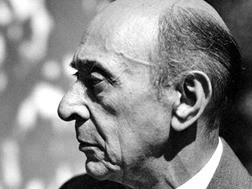
Roots of 20th Century Music: Dancing on a Volcano (Leaving Home: Orchestral Music in the 20th Century. Volume 1. ) 1997
Distributed by Films Media Group, PO Box 2053, Princeton, New Jersey 08543-2053; 800-257-5126
Produced by RM Associates
Director n/a
VHS, color, 52 min.
Adult
Music
Date Entered: 11/09/2018
Reviewed by Brad Eden, Ph.D., Head, Web and Digitization Services, University Libraries, University of Nevada, Las VegasThis video is the first of a seven-volume series introducing the music of the twentieth century to the public. Simon Rattle acts as narrator/tour guide throughout the series, directing the City of Birmingham Symphony Orchestra through his discussions of the major composers, events, and compositions that comprise twentieth century music. Along with glimpses of the orchestra playing the compositions that Rattle discusses, are a montage of nature scenes that evoke a "new age" flavor to the video series.
Volume 1 deals with turn of the century Vienna and the artistic groups and individuals that began the break away from the Romantic ideals of Wagner. Rattle discusses first how Tristan and Isolde (1857) by Wagner experiments with tonality and how the Tristan chord never resolves in the usual tonal sense. From there, a number of composers and compositions are discussed, always with Rattle conducting selections with his orchestra or playing examples on the piano. Composers and compositions discussed include: Schoenberg, Transfigured Night (1899); Mahler, Symphony No. 7, 3rd movement; Strauss, Elektra (1909); Schoenberg, 5 Pieces for Orchestra (1913)(all 5 movements are played and discussed, including #4, where the 12 tone row is used for the first time); and Berg, Violin Concerto (1935). In each of these pieces, Rattle presents the specific situation or technique that makes it unique in twentieth century music.
Not only do I find this method of discussion/performance important to the presentation and learning of music appreciation, but the concept of showing flowing water, expressionist paintings, and various other scenes from nature and early twentieth century Vienna as an excellent and almost soothing way to present this information to the public. Rattle is an excellent teacher and conductor, and speaks throughout the video as if in a classroom and directly to the viewer. He is concise and direct in his presentation, and speaks with ease to a non-music audience without sounding too technical. As a musicologist, I was impressed with the directness, presentation of music, and the discussion of this particular time period in the history of music. This video is an excellent introduction for music teachers to use in twentieth century music classes, as well as for the general public with no knowledge of music history.